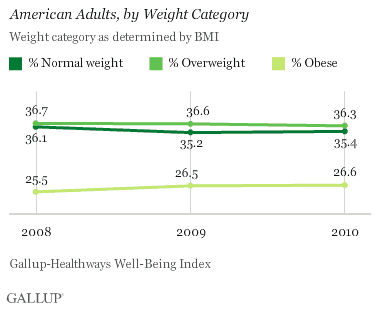WASHINGTON, D.C. -- More than 6 in 10 American adults (62.9%) were either overweight (36.3%) or obese (26.6%) in 2010, on par with 2009, but still slightly more than the 62.2% in 2008. The corollary of this is that the percentage of Americans of normal weight, now 35.4%, was also about the same last year as in 2009, but down slightly from 2008.

The 2010 data encompass more than 300,000 surveys of American adults. The Gallup-Healthways Well-Being Index uses respondents' self-reports of their height and weight to calculate body mass index (BMI) scores. Individual BMI values of 30 or above are classified as "obese," 25 to 29.9 are "overweight," 18.5 to 24.9 are "normal weight," and 18.4 or less are "underweight."
Quarterly tracking of Americans' weight situation reveals that obesity levels dropped slightly in the last quarter of 2010, but the percentage who were overweight increased by about the same amount.

Obesity levels rose above 26% in the first quarter of 2009 and have remained at that level since then. Slightly more Americans have been overweight than normal weight each quarter since Gallup and Healthways began tracking BMI in the United States in 2008.
More Than 3 in 10 Black, Low-Income, and Middle-Aged Americans Obese
Black Americans continue to struggle with their weight the most, with 36% obese in 2010. Low-income Americans and adults aged 45 to 64 are also among the most likely to be obese, as they were in past years. Obesity levels increase with age -- until they drop among seniors. The likelihood to be obese decreases as income rises.
The groups least likely to be obese in 2010 include high-income Americans, young adults, and Asian Americans, as in 2009 and 2008. Americans living in the West and East also continue to be less likely to be obese than those living in the Midwest and South.

There was essentially no significant change from 2009 to 2010 in the percentage obese across all of the demographic groups analyzed. However, across the board, Americans -- with the exception of Asian Americans -- are more likely to be obese in 2010 than they were in 2008.
Bottom Line
The stability in obesity levels in 2010 could be a good sign that at least some Americans are attempting to better manage their weight. Still, more than one in four American adults remain obese, putting them at risk for a slew of chronic illnesses and increasing their individual and the nation's collective healthcare costs. A Gallup analysis found that if the 10 most obese U.S. cities reduced their rates to the national average, they could collectively save about $500 million in healthcare costs a year. In addition, the National Research Council Tuesday released a new study linking Americans' obesity levels to their shorter life expectancy compared with residents of other high-income countries.
The new healthcare law requires certain health insurance plans to offer free preventive services including weight loss counseling, which may have a positive influence on Americans' eating and exercise habits and lead to lower obesity levels. If the requirement that all Americans purchase health insurance remains intact, these new preventive services could reach even more people -- particularly low-income Americans, who face the double burden of being among the most likely to be obese and to be uninsured. Decreasing obesity levels, however, cannot be accomplished through medical care or counseling alone; individual citizens have to commit to leading healthier lifestyles on their own, including exercising more frequently and eating better foods.
About the Gallup-Healthways Well-Being Index
The Gallup-Healthways Well-Being Index tracks U.S. well-being and provides best-in-class solutions for a healthier world. To learn more, please visit well-beingindex.com.
Survey Methods
Results are based on telephone interviews conducted as part of the Gallup-Healthways Well-Being Index survey Jan. 1-Dec. 31, 2010, with a random sample of 333,213 adults, aged 18 and older, living in all 50 U.S. states and the District of Columbia, selected using random-digit-dial sampling.
For results based on the total sample of national adults, one can say with 95% confidence that the maximum margin of sampling error is ±1 percentage point.
For results based on subgroups, one can say with 95% confidence that the maximum margin of sampling error is ±1 percentage point.
Interviews are conducted with respondents on landline telephones and cellular phones, with interviews conducted in Spanish for respondents who are primarily Spanish-speaking. Each daily sample includes a minimum quota of 200 cell phone respondents and 800 landline respondents, with additional minimum quotas among landline respondents for gender within region. Landline respondents are chosen at random within each household on the basis of which member had the most recent birthday.
Samples are weighted by gender, age, race, Hispanic ethnicity, education, region, adults in the household, cell phone-only status, cell phone-mostly status, and phone lines. Demographic weighting targets are based on the March 2010 Current Population Survey figures for the aged 18 and older non-institutionalized population living in U.S. telephone households. All reported margins of sampling error include the computed design effects for weighting and sample design.
In addition to sampling error, question wording and practical difficulties in conducting surveys can introduce error or bias into the findings of public opinion polls.
For more details on Gallup's polling methodology, visit https://www.gallup.com/.
